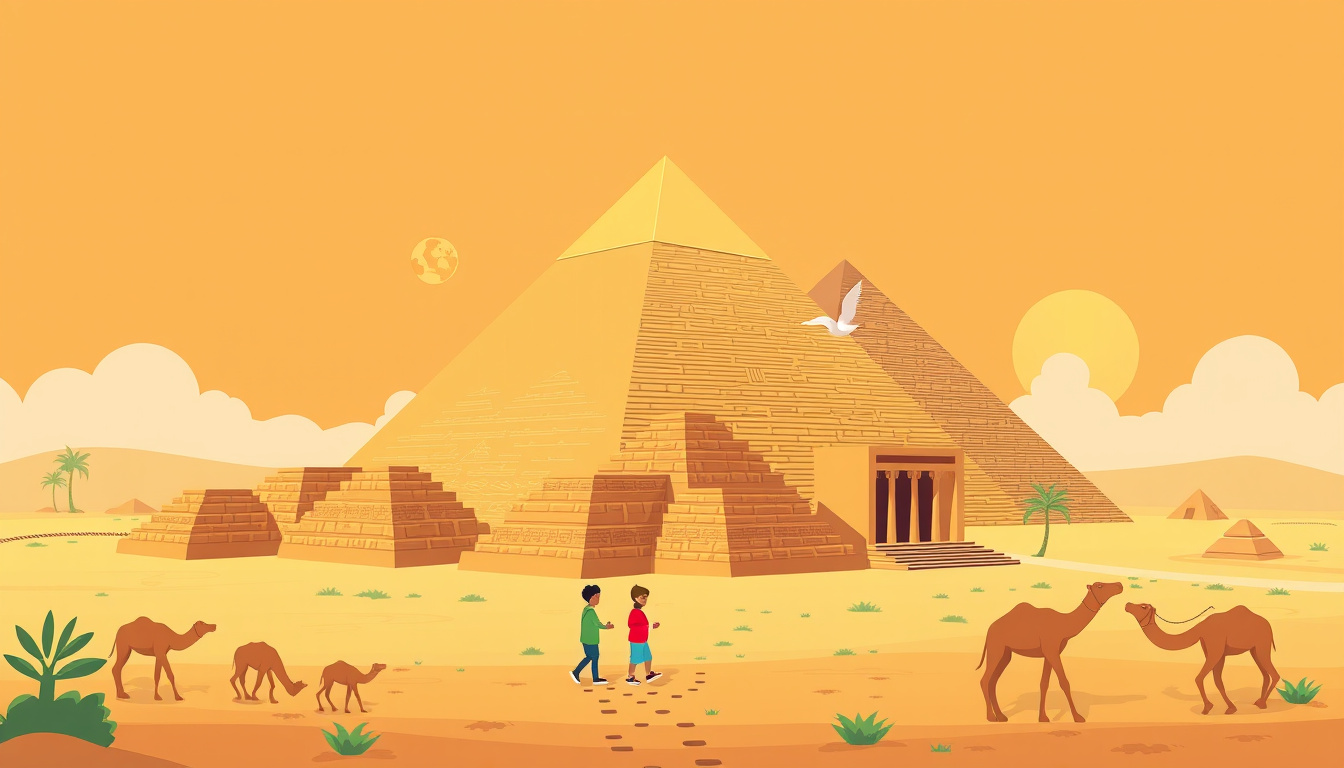The Great Pyramids of Giza are among the most iconic symbols of ancient civilization, standing as grand monuments to the ingenuity of humankind. Located on the Giza Plateau in Egypt, these magnificent structures have captured the imagination of countless visitors over the centuries. Let’s embark on an exciting journey together to explore some fascinating facts about these ancient wonders, specifically designed for inquisitive young minds.
The Grand Introduction: What Are the Pyramids of Giza?
The Pyramids of Giza are three enormous structures: the Great Pyramid of Khufu, the Pyramid of Khafre, and the Pyramid of Menkaure. Each pyramid was built as a tomb for an ancient Egyptian pharaoh and reflects the significance of these rulers in ancient society. The Great Pyramid, the largest of the three, towers at an impressive height of 146 meters (or about 481 feet) and was once shrouded in smooth, white limestone that made it gleam in the sun.
Did You Know?
- Location: The journey to Giza is part of a special historical exploration, just a short drive from Cairo, the bustling capital of Egypt.
- Construction Period: The Great Pyramid was constructed approximately 4,500 years ago during Egypt’s Old Kingdom era, taking around 20 years to complete.
The Magnificent Achievement: How Were They Built?
What is truly astonishing is the construction of these monumental structures using techniques that remain a mystery to this day. Estimates suggest that over 100,000 workers, including skilled laborers, were involved in the building processes, moving approximately 2.3 million stone blocks for the Great Pyramid alone! These blocks weighed between 2.5 tons and 15 tons each!
Theories of Construction
Archaeologists and scientists have put forward various theories about how the pyramids were constructed. Some believe the stones were transported from nearby quarries using sledges and water to reduce friction. Others suggest that ramps were created to help move the stones into place as the pyramid rose higher.
Fun Fact
Despite modern technology, replicating the precision and scale of the Great Pyramid today remains a challenge. The ancient builders’ architectural skills and tools continue to baffle experts.
The Treasure Within: Pharaoh Khufu’s Tomb
The Great Pyramid was built as a final resting place for Pharaoh Khufu. Ancient Egyptians believed in the afterlife, and they dedicated significant resources to ensure their pharaohs had everything they needed in the next life. Khufu’s tomb was designed to house his mummified body and contained treasures, including jewelry, food, and other offerings.
Intriguing Mystery
Interestingly, while ancient tombs typically featured beautiful hieroglyphics that depicted the pharaoh’s life and the gods, Khufu’s tomb is notably bare. This raises questions for archaeologists about the purpose and design of his burial place.
The Spectacle of the Sphinx
As you explore the Giza Plateau, you will also encounter the Great Sphinx, another captivating marvel! This massive statue features a lion’s body and a human head – believed to represent Pharaoh Khafre – and measures 73 meters (238 feet) long and 20 meters (66 feet) high.
Historical Significance
The Sphinx is not just an artistic masterpiece; it also symbolizes strength and wisdom. Its enigmatic presence has led to many myths and stories over the centuries.
The Glistening Exterior: Vibrant and Bright
Originally, the pyramids were encased in smooth, polished limestone, which made them shine brightly under the Egyptian sun. It’s said that the very top of the Great Pyramid was covered in gold, allowing it to catch the light and dazzle all who approached.
Did You Know?
The pyramids were more than tombs; they also symbolized the pharaohs’ divine right to rule and their connection to the gods. The glistening pyramids also served as a manifestation of a grand journey to the afterlife.
The Enchantment of Ancient Egypt: What Can We Learn?
Visiting the Great Pyramids of Giza not only fills us with wonder about the architectural wonders but also sparks curiosity about the people who lived during that era. The ancient Egyptians were remarkable for their achievements in various fields, from engineering to art and religion. Their legacies continue to inspire us to this day.
Encouraging Exploration
Learning about ancient civilizations encourages kids to ask questions, seek out knowledge, and inspire creativity. Understanding history opens the door to numerous subjects, such as archaeology, art, and engineering.
Frequently Asked Questions (FAQ)
1. How many pyramids are there in Egypt?
There are over 100 pyramids scattered throughout Egypt, built as tombs for various pharaohs.
2. What is the purpose of the pyramids?
The primary purpose of the pyramids was to serve as tombs for pharaohs, providing them with a place for their remains and treasures for the afterlife.
3. What do hieroglyphics mean?
Hieroglyphics are a form of ancient writing used by the Egyptians that combine pictures and symbols to represent sounds, words, or ideas.
4. Why is the Sphinx famous?
The Sphinx is famous because of its massive size, unique depiction of a lion with a human head, and its mysterious origins.
5. How can we visit the pyramids?
Many tours are available that allow visitors to explore Giza, providing insights into the history and culture of ancient Egypt. Always check travel guidelines and recommendations before planning a visit.
Conclusion
The Great Pyramids of Giza are much more than just ancient structures; they are a testament to the creativity, resilience, and intellect of the ancient Egyptians. Their mystery endures through the ages, allowing generations to marvel at their grandeur and consider the stories they tell. As we reflect on their significance, let us encourage young explorers to learn more about our world, understanding that history is not merely a sequence of dates and events but a treasure trove of stories waiting to be discovered!

